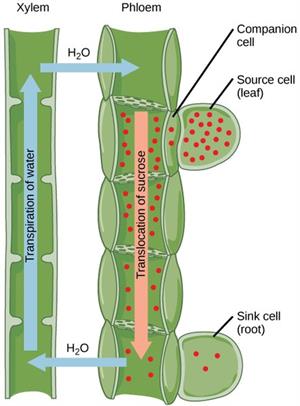PDF chapter test TRY NOW
As discussed, translocation of organic solutes refers to the movement of organic food components or soluble solutes from one location to another in higher plants.
These organic solutes include the soluble products of photosynthesis, amino acids and other substances.
It is a process that occurs in the sieve tubes with the help of adjacent companion cells in both upwards and downwards direction.
Directions of translocation:
Translocation of organic solutes may take place in the following directions.
Translocation of solutes
Downward translocation:
It is the transport of the products of photosynthesis from the leaves to the stems and roots for consumption and storage. It takes place in the sieve tubes with the help of adjacent companion cells.
Upward translocation:
It occurs primarily during the germination of seeds, tubers, and other plants. When food is stored and transformed into a soluble form, it is transferred to the young seedling's upper growth section until it develops green leaves.
Solutes are also transported upward from the stem to the tip of the branch, where young leaves, buds, and flowers are found. Although translocation of organic solutes takes place through the phloem, but under certain conditions, it may take place through the xylem.
The phenomenon of translocation:
- Unlike xylem transportation, which is primarily explained by basic physical forces, phloem translocation requires ATP usage.
- Sucrose is transported into phloem tissue with the help of ATP energy. This causes the osmotic pressure of the tissues to rise, allowing water to enter.
- The substance in the phloem is moved to tissues with less pressure due to this osmotic pressure. This enables the phloem to transfer material following the needs of the plant.
Important!
Various theories related to the mechanism of translocation will be explained in detail in higher classes.
Differences between Xylem and Phloem:
|
Xylem
|
Phloem
|
|
Xylem conducts minerals and water.
|
Phloem conducts food and organic solutes.
|
|
Xylem conducts in one way i.e., unidirectional conduction from roots to apical parts (tips of the plant ) of the plant.
|
Phloem conducts in two ways. i.e., bidirectional conduction of food from leaves to storage organs.
And also from storage organs to growing parts of the plant.
|
|
Channels that help Xylem for conduction are tracheid and vessels.
|
Channels that help phloem for conduction are sieve tubes.
|
|
Xylem consists of the components such as tracheid, vessels, xylem parenchyma and xylem fibres.
|
Phloem consists of the components such as sieve elements, companion cells, phloem parenchyma and phloem fibres.
|
|
Lumen is narrow.
|
Lumen is wider.
|
| Xylem fibres are smaller. | Phloem fibres are larger. |
| It is made up of dead cells. | It is made up of living cells. |
| The cell wall of xylem is made up of lignin. | The cell wall of phloem is made of cellulose. |
| It helps in the passive transport of water. | It helps in the active transport of sugar and food. |
| It provides mechanical support. | Does not provide mechanical support. |
